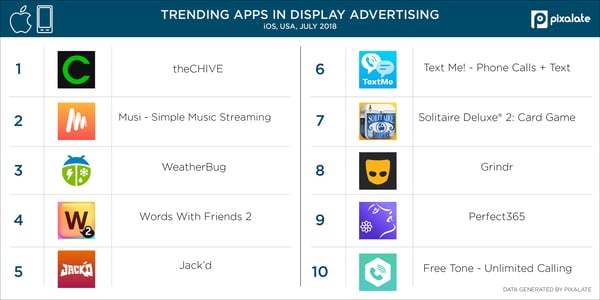
This week's review of ad fraud and quality in the digital advertising space.

Pixalate reveals the top trending iPhone apps for display and video advertisers in the U.S. from July 2018. The Apple App Store contains millions of apps, and this data cuts through the clutter to show marketers which apps are making the most money from digital advertising. This data can also help marketers identify new apps on which they can reach their audience.

MediaPost reports on a new report from PubMatic, which notes that mobile in-app ad spend is on the rise. "From the second quarter of 2017 to the second quarter of 2018, mobile video ad spend increased by 239% -- including 688% year-over-year growth via apps, and 73% year-over-year via mobile web," reported MediaPost.

"Scammers are utilizing free .TK domains to redirect users from hacked sites to fake blogs created for the sole purpose of displaying advertisements or tech support scams," reported Bleeping Computer, citing research from Zscaler. "This scheme works by attackers compromising web sites and installing scripts that redirect visitors through a series of sites. At the end of this redirect chain will either be a tech support scam stating that the computer is infected with the Zeus virus or a fake blog site that display popups ads that cannot be closed."

Citing a CMO Council and SAP study, eMarketer details which types of data the General Data Protection Regulation (GDPR) is expected to impact the most. The article notes: "54% of respondents said they anticipate that they’ll no longer be able to use behavioral data like web browsing data and search histories if they want to stay compliant with the GDPR."

The New York Times outlines Amazon's progress in the world of online advertising. "Amazon ... is quickly gathering momentum in a new, highly profitable arena: online advertising, where it is rapidly emerging as a major competitor to Google and Facebook," the article notes.
Sign up for our blog to stay updated with new stats, trends, and analysis of digital ad fraud.
*By entering your email address and clicking Subscribe, you are agreeing to our Terms of Use and Privacy Policy.
These Stories on Weekly Recaps
*By entering your email address and clicking Subscribe, you are agreeing to our Terms of Use and Privacy Policy.

Disclaimer: The content of this page reflects Pixalate’s opinions with respect to the factors that Pixalate believes can be useful to the digital media industry. Any proprietary data shared is grounded in Pixalate’s proprietary technology and analytics, which Pixalate is continuously evaluating and updating. Any references to outside sources should not be construed as endorsements. Pixalate’s opinions are just that - opinion, not facts or guarantees.
Per the MRC, “'Fraud' is not intended to represent fraud as defined in various laws, statutes and ordinances or as conventionally used in U.S. Court or other legal proceedings, but rather a custom definition strictly for advertising measurement purposes. Also per the MRC, “‘Invalid Traffic’ is defined generally as traffic that does not meet certain ad serving quality or completeness criteria, or otherwise does not represent legitimate ad traffic that should be included in measurement counts. Among the reasons why ad traffic may be deemed invalid is it is a result of non-human traffic (spiders, bots, etc.), or activity designed to produce fraudulent traffic.”

